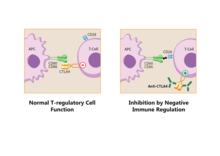Topic: CD86 edit
Four recent review articles that seem relevant: Regulatory T (Treg) cells in cancer: Can Treg cells be a new therapeutic target? (2019)[1]
Survival of Long-Lived Plasma Cells (LLPC): Piecing Together the Puzzle (2019)[2]
Targeting B7‐1 in immunotherapy (2019)[3]
Immune checkpoints and their inhibition in cancer and infectious diseases (2017)[4]
Draft: edit
Cluster of Differentiation 86 (also known as CD86 and B7-2) is a protein expressed on dendritic cells, macrophages, B-cells, and other antigen-presenting cells. Along with CD80, CD86 provides costimulatory signals necessary for T-cell activation and survival. Depending on the ligand bound, CD86 can be used to signal for self-regulation and cell-cell association, or for attenuation of regulation and cell-cell disassociation.[5]
The CD86 gene encodes a type I membrane protein that is a member of the immunoglobulin superfamily.[6] Alternative splicing results in two transcript variants encoding different isoforms. Additional transcript variants have been described, but their full-length sequences have not been determined.[7]
Co-stimulation for T-cell activation edit
The binding of CD86 (or the closely related protein CD80) expressed on the surface of an antigen-presenting cell with CD28 on the surface of a mature, naive T-cell, is required for T-cell activation.[4] This protein interaction, along with the primary signal that is the MHC class II with an attached peptide binding to the T-cell receptor (TCR), activates mitogen-activated protein kinase and transcription factor nf-κB in the T-cell. These proteins up-regulate production of CD40L (used in B-cell activation), IL-21 and IL-21R (used for division/proliferation), and IL-2, among other cytokines. [4]

T-reg mediation edit
T-regulatory cells produce CTLA-4, which can dampen an immune response and lead to increased anergy.[1] CTLA-4 binds to CD86 with greater affinity than CD28, which impairs the co-stimulation necessary for proper T-cell activation. When bound to CTLA-4, CD86 can be removed from the surface of an APC and onto the T-reg cell in a process called trogocytosis.[1] Blocking this process with anit-CTLA-4 antibodies is useful for a specific type of cancer immunotherapy called cancer therapy by inhibition of negative immune regulation. Japanese immunologist Tasuku Honjo and American immunologist James P. Allison won the Nobel Prize in Physiology or Medicine in 2018 for their work on this topic.
References edit
- ^ a b c Ohue, Yoshihiro; Nishikawa, Hiroyoshi (2019-07). "Regulatory T (Treg) cells in cancer: Can Treg cells be a new therapeutic target?". Cancer Science. 110 (7): 2080–2089. doi:10.1111/cas.14069. ISSN 1347-9032. PMC 6609813. PMID 31102428.
{{cite journal}}: Check date values in:|date=(help)CS1 maint: PMC format (link) - ^ Lightman, Shivana M.; Utley, Adam; Lee, Kelvin P. (2019-05-03). "Survival of Long-Lived Plasma Cells (LLPC): Piecing Together the Puzzle". Frontiers in Immunology. 10: 965. doi:10.3389/fimmu.2019.00965. ISSN 1664-3224. PMC 6510054. PMID 31130955.
{{cite journal}}: CS1 maint: PMC format (link) CS1 maint: unflagged free DOI (link) - ^ Chen, Rui; Ganesan, Aravindhan; Okoye, Isobel; Arutyunova, Elena; Elahi, Shokrollah; Lemieux, M. Joanne; Barakat, Khaled (2019-08-25). "Targeting B7‐1 in immunotherapy". Medicinal Research Reviews: med.21632. doi:10.1002/med.21632. ISSN 0198-6325.
- ^ a b c Dyck, Lydia; Mills, Kingston H.G. (2017-05). "Immune checkpoints and their inhibition in cancer and infectious diseases". European Journal of Immunology. 47 (5): 765–779. doi:10.1002/eji.201646875.
{{cite journal}}: Check date values in:|date=(help) - ^ Ohue Y, Nishikawa H (July 2019). "Regulatory T (Treg) cells in cancer: Can Treg cells be a new therapeutic target?". Cancer Science. 110 (7): 2080–2089. doi:10.1111/cas.14069. PMC 6609813. PMID 31102428.
- ^ Chen C, Gault A, Shen L, Nabavi N (May 1994). "Molecular cloning and expression of early T cell costimulatory molecule-1 and its characterization as B7-2 molecule". Journal of Immunology. 152 (10): 4929–36. PMID 7513726.
- ^ "Entrez Gene: CD86 CD86 molecule".
